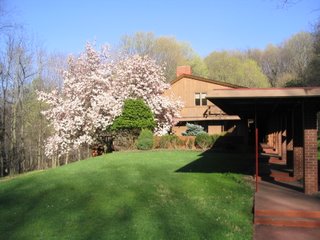A Home

I am celebrating my fifth anniversary in my home -- designed by Frank Lloyd Wright apprentice Peter Berndtson around 1960-4 -- by bringing in a bunch of contractors, aided by an architect who understands the work of Peter Berndtson and can help me make choices that preserve Berndtson's vision and intent. This summer I am renovating two of the three decks on the second floor.
Another architect, Albert Walters, once said of Berndtson: "Peter was one of the most totally self-centered people I have ever known . . . [he] embodied the character of Howard Roark [from Ayn Rand's The Fountainhead] more than anyone I ever knew." Others have disputed this characterization (Edgar Tafel told me that Berndtson was a "nice man" -- whatever that might mean), but it is clear that in learning his craft at the knee of Wright, Berndtson also learned to emulate something of Wright's elitism and arrogance.
A some-time designer of stage sets, Berndtson joined Wright's Taliesin Fellowship in Wisconsin in 1938 and became one of Wright's most devoted pupils and disciples, working with the master on his renderings of the Guggenheim Museum in New York City. During the 1940s, Berndtson settled in Pittsburgh with his second wife, Taliesin architect and historian Cornelia Brierly, where he became an important designer of Wright-influenced residences -- "organic" structures which were designed with uncompromising discipline to be integrated with the land in their basic lines, their materials and their treatment of natural light. He passed away in 1972.
This excerpt from Miller and Sheon's book Organic Vision: The Architecture of Peter Berndtson, explains a bit about what is special about my particular house:
One house that tested all of the architect's ingenuity was 'Springwater Hills,' the home of Mr. and Mrs. Arthur Parkins . . . The Parkinses owned 40 wooded acres surrounding a handsome grassy knoll -- on which stood a typical late Victorian clapboard farmhouse with gable roof. Berndtson first saw the site in 1953. He suggested razing the small farmhouse and starting fresh. At the time the Parkinses felt the expense prohibitive and in any case did not want to start from scratch. Ten years later they began long discussions about adapting the house.
' Peter was amenable to an adaptation,' Parkins said. 'But he told me it would be a most difficult challenge to make his architecture come together with the existing building. We knew what he meant. He looked over the place a few times and then disappeared for about six months. When he finally came out with the plans, the drawings were incredible. We fell in love with his ideas right away. Even if we had been inclined to, after seeing what he intended we probably could not have looked for another architect. You just couldn't deny his work,' the Parkinses said.
'I said I thought Micarta surfaces would be practical in the bedrooms,' Arthur Parkins remembered. 'If you want that you'll need a different architect,' Peter replied.'
'We let him do what he wanted,' Loretta Parkins said, 'because everything he did was beyond our expectations. The house, with three decks on the second floor, four bedrooms and two baths, is like a sculpture. We have made no attempt to overdress it. Just a few flowers. Peter included corner flower boxes on the northwest deck. There was nothing that we didn't let Peter do. He had total freedom and we're not sorry!'
Parkins agreed. 'Peter had a unified design. He nurtured ideas like sculptural entities and he never deviated from his ideals.'
On of their house's most unusual features is a long walkway with a redwood canopy that extends many feet from the front of the house in the direction of a separate garage. The house has a strong Japanese quality with its stark redwood exterior. Except for one area of the original roofline, there is nothing to indicate the house's beginnings. Berndtson enclosed the original structure but refinished the interior as the core of his enlargement. It was a brilliant experiment.
One feature of the house that Miller and Sheon fail to mention, except in passing, is its surroundings -- the thick, green woods; the lush rhododendrons that hug the structure on the east and west sides; and the gentle hiss of the two springs that traverse the land on which it is situated. The land itself was part of the attraction for me, and one of the things that drew me to visit when I first read that this Berndtson house was for sale by the Parkinses. It was an emotional experience for me to wake up in this forest for the first time five years ago after moving in. In the master bedroom, with glass expanses on either side of the built-in platform bed, and narrow windows on either side of the fireplace at the far end of the room, it was easy to be overwhelmed by being enveloped within the forest's colors and sounds. In this most private haven, it was as if there were no sense of time.

Labels: Architecture, Frank Lloyd Wright





3 Comments:
...and a lovely home it is. I cannot wait to share cocktails on said deck(s) during the fall foliage season!
Hear that Santa actually teaches deer to fly near this fine looking home. Kind of a flight school for deer or so I've been told.
My father was the Albert Walters you have quoted and I am most certain that what you are stating is a misquote. My father worked for Peter and loved the man; he always spoke highly of him, near reverence. There is a chance that my father may have worked on the design of your house as I believe he was working for Peter as a designer/draftsman at about that time.
Post a Comment
Subscribe to Post Comments [Atom]
<< Home